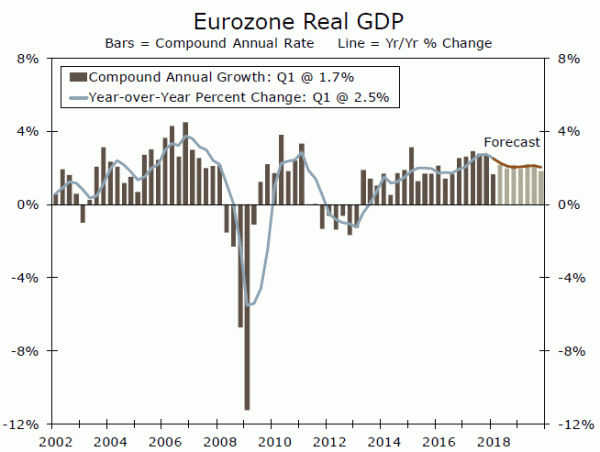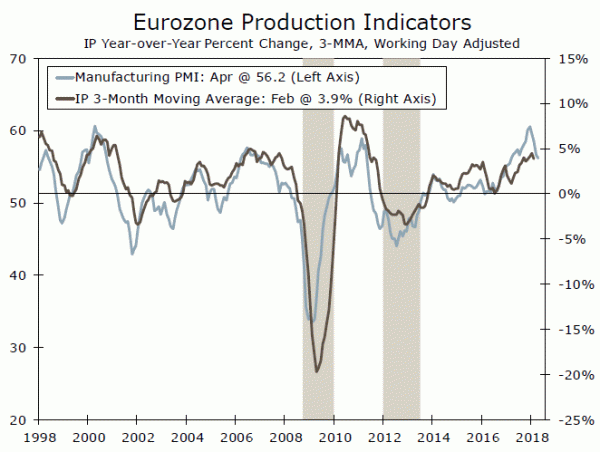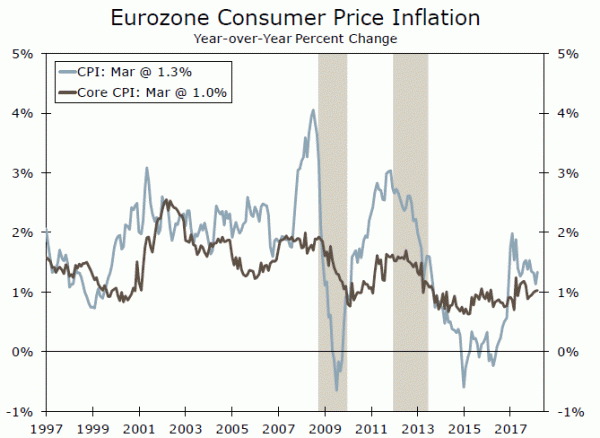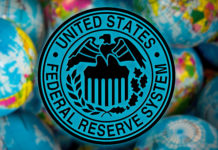Real GDP in the Eurozone grew 0.4 percent in Q1, largely matching consensus estimates. Although we look for the Eurozone’s expansion to remain in place, persistently low inflation remains a roadblock for the ECB.
Eurozone GDP Decelerates Slightly in Q1
Data released today showed that real GDP in the Eurozone grew 0.4 percent in Q1 (1.7 percent annualized), largely in line with consensus expectations. While data on underlying demand components is not available at this time, today’s print shows that growth in the Eurozone likely peaked toward the end of 2017. We look for GDP growth to slow modestly this year to roughly 2 percent from 2.5 percent in 2017, especially as we also look for global growth to converge toward its long-run trend after surprising to the upside last year. But we forecast the Eurozone’s expansion to remain intact. As noted below, the monetary policy environment should remain supportive of growth, and fiscal policy is also generally not restricting growth at present.
Monthly Data Corroborate Q1 Slowdown
Monthly data largely support the modest deceleration in Q1. Growth in industrial production has been negative through the first two months of the year, and the manufacturing PMI has also moderated slightly following record highs above 60 seen at the end of 2017 (middle chart). Growth in real retail sales has also been lackluster so far this year, and will likely be reflected in slower personal consumption growth for Q1. However, the unemployment rate continues to decline, and the overall growth rate registered in Q1 is still above the Eurozone economy’s potential growth rate, meaning the output gap should gradually continue to narrow.
Low Inflation Means Slow and Steady for the ECB
While growth in the Eurozone largely remains solid even with the Q1 slowdown, inflation continues to be persistently below the European Central Bank’s (ECB) “below, but close to, 2 percent target,” proving a roadblock to more rapid policy normalization. Consumer price inflation rose 1.3 percent year over year in March, and has remained below 2 percent since early 2017 (bottom chart). Core inflation has been hovering around 1 percent, and the consensus looks for it to drop to 0.9 percent in April.
Given below-target inflation, the ECB has continued its asset purchase program and maintained record-low interest rates even as other large central banks have begun to remove accommodation. In the press conference following the ECB’s latest decision on April 26, President Draghi stated that, “an ample degree of monetary stimulus remains necessary for underlying inflation pressures to continue to build up.” We look for the ECB to continue its €30 billion per month pace of asset purchases through September, before tapering further to €10-€15 billion per month through the end of the year. The ECB has also signaled that it is in no hurry to tighten policy even after it ends its bond-buying program. We look for it to raise the deposit rate from -0.40 percent to -0.20 percent sometime next spring, then hike its main refinancing rate next summer.















